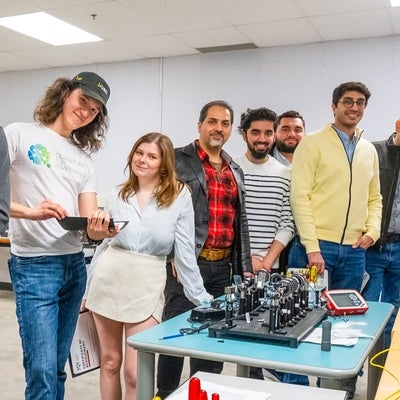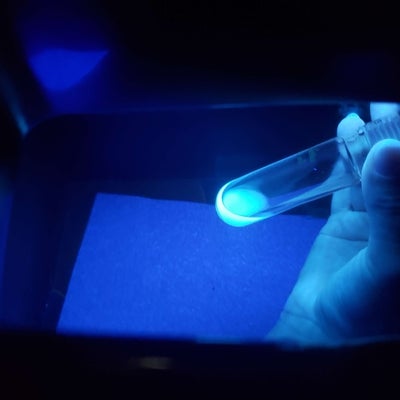
Waterloo Pharmacy MSc student and team win Q4Environment Design Challenge Silver Award
Sustainable quantum dots detect lead in water
Nicholas Cheng, Waterloo Pharmacy MSc student didn’t expect his side project, Entomatia, to launch another side project – repurposing the discarded insect shells for consumer detection of lead in water at home.
Transformative Quantum Technologies (TQT) awarded Cheng and his team a Quantum for Environment (Q4Environment) Design Challenge Silver Award for their project: Insect-based carbon quantum dots: highly sensitive pollutant sensing in environmental contexts. This $1,500 award recognizes sustainable ideas whose aim is to find solutions for worldwide environmental concerns.
Team members consist of Courtney MacPherson, University of Waterloo Global Business and Digital Arts student, Nicholas Cheng, University of Waterloo School of Pharmacy MSc student, Starla Richardson, Wilfrid Laurier University PhD student and Manuel Ron Lleras, aquatic biologist at LEA consulting.
Although exposure to lead has decreased in Canada, it is still a public health concern due to aging infrastructure and is particularly harmful to children who are most vulnerable. Even low levels of lead exposure can affect their development and behavior. Water treatment plants remove lead contamination effectively, but the concern is after treatment – when water travels through aging municipal pipes to homes, accumulating lead on the way.
Left: Nicholas Cheng and Courtney MacPherson at the Q4 Environmental Design Challenge with other winners. Photo credit from the event: Anthony Ramsay, Computing Support Specialist, Institute for Quantum Computing. Right: A vial containing quantum dots emitting blue light. Photo credit: Nicholas Cheng.
Currently there is no way for a homeowner or the general public to test their water for the presence of lead. We want to offer the first ever consumer-friendly sustainable solution to lead testing in water samples that is cost-effective, accurate and safe.
“The by-product of this process is biodegradable, allowing for eco-friendly disposal by simply pouring the liquid down the sink and recycling the cartridge. We wanted to ensure that the entire user experience, from using the sensing device to disposing of the cartridge, aligns with our sustainability goals and provides a seamless experience,” MacPherson adds.
Using Cheng’s insect shells, the team created a quantum dot, a tiny particle sometimes known as an artificial atom that is smaller than a virus’ cell. These quantum dots are designed to interact with very specific wavelengths of UV light, producing visible light through fluorescence and are incredibly sensitive to detecting pollutants. When lead binds to the dot, the dot stops emitting light, indicating the presence of lead.
“Unlike traditional methods that rely on toxic reagents, with temperatures often above 180°C, and heating times longer than 12 hours, our approach to carbon quantum dots is a breakthrough in green chemistry,” Richardson says. “Using a sustainable carbon source, bug shells, and a conventional microwave, we've simplified the process to just a few minutes. This means we can empower consumers with advanced science without harming the environment!”
“This project can make lead testing accessible to a larger population, especially in low-income communities, and for water testing in spill offs from disaster areas,” MacPherson adds.
Many filters reduce the lead found in our water, such as a Santevia filter, which puts residents at ease, but early detection of lead in our drinking water can prevent ingestion and adverse health effects in humans and wildlife.
“This recognition has given us the confidence and push to further develop this technology. I really resonate with Lazaradis’ dream to be a leader of Quantum in the Region of Waterloo and hope to work with leaders in Canada,” Cheng says.
The team is conducting additional user testing, further market research, as well as seeking grants and partnerships to further develop this project.
The Q4Environment Design Challenge was made possible by Quantum Valley Ideas Laboratory, National Research Council of Canada, Honeywell Aerospace, Angstrom Engineering, and Ambature. Visit Waterloo News to read more on Q4Environment Design Challenge winners.



